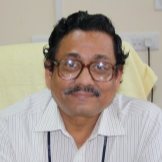
Kankar Dasgupta
Work place: Indian Institute of Space Science and Technology, Valiamala, Thiruvananthapuram - 695547, India
E-mail: ksd@iist.ac.in
Website:
Research Interests: Computer systems and computational processes, Computer Architecture and Organization, Systems Architecture, Image Manipulation, Network Architecture, Image Processing
Biography
K. S. Dasgupta received his B.E. and M.E. degrees in Electronics and Telecommunication from Jadavpur University, India in 1972 and 1973 respectively.He received his Ph.D. degree in Computer Science from Indian Institute of Technology, Mumbai in 1990. He joined Space Applications Centre(SAC), a branch of Indian Space Research Organization (ISRO) in 1974. He was involved in the design and development of communication systems and payloads for geosynchronous satellite projects. He led a team that developed various SATCOM applications including, rural telephony and grid computation. He was the chief technical architect of the GSAT-4 regenerative payload. He served as the Director of Development and Educational Communication Unit (DECU), Ahmedabad, India before joining Indian Institute of Space Science and Technology (IIST), Thiruvananthapuram, India. Currently he is Director, IIST since December 2010. He is a recipient of the ISRO performance excellence award for the year 2009. His research interests include Digital Signal Processing, Digital Image Processing, Computer Architecture, Digital Communication and Onboard Processing Satellites.
Author Articles
LEFT: A Latency and Energy Efficient Flexible TDMA Protocol for Wireless Sensor Networks
By Sachin Gajjar Nilav Choksi Mohanchur Sarkar Kankar Dasgupta
DOI: https://doi.org/10.5815/ijcnis.2015.02.01, Pub. Date: 8 Jan. 2015
This paper proposes latency and energy efficient flexible TDMA (LEFT), a medium access control (MAC) combined with routing protocol for data gathering from number of source nodes to a master station (MS) in a wireless sensor network (WSN). TDMA provides fairness, collision-free communication and reduces idle listening, which saves network energy. Data latency is reduced by allocating same transmission slots to nodes falling out of interference range of each other. Unlike a conventional TDMA, LEFT provides flexibility through slot seizing, wherein a non-holder of a slot can use slot when holder does not have data to send. This increases channel utilization and adaption to dynamic traffic patterns of WSN applications. Further, a node on a multi-hop path towards MS decides to participate in routing based on (i) its location with respect to MS, to forward data in correct direction, (ii) its current status of residual energy, to uniformly distribute energy across network, (iii) its transit traffic load, to prevent local congestion, (iv) its communication link quality, to guarantee reliable data delivery. This decision requires simple comparisons against thresholds, and thus is very simple to implement on energy, storage and computationally constrained nodes. LEFT also encompasses techniques to cater to link and node breakdowns. Experimental analysis of LEFT; Advertisement-based TDMA; Data gathering MAC; Energy Efficient Fast Forwarding and Cross layer MAC protocols using TI’s EZ430-RF2500T nodes shows that LEFT is 65% more energy efficient compared to Cross layer MAC. Data latency of LEFT is 27 % less, delivery ratio is 17 % more and goodput is 11 % more compared to Cross layer MAC.
[...] Read more.Other Articles
Subscribe to receive issue release notifications and newsletters from MECS Press journals